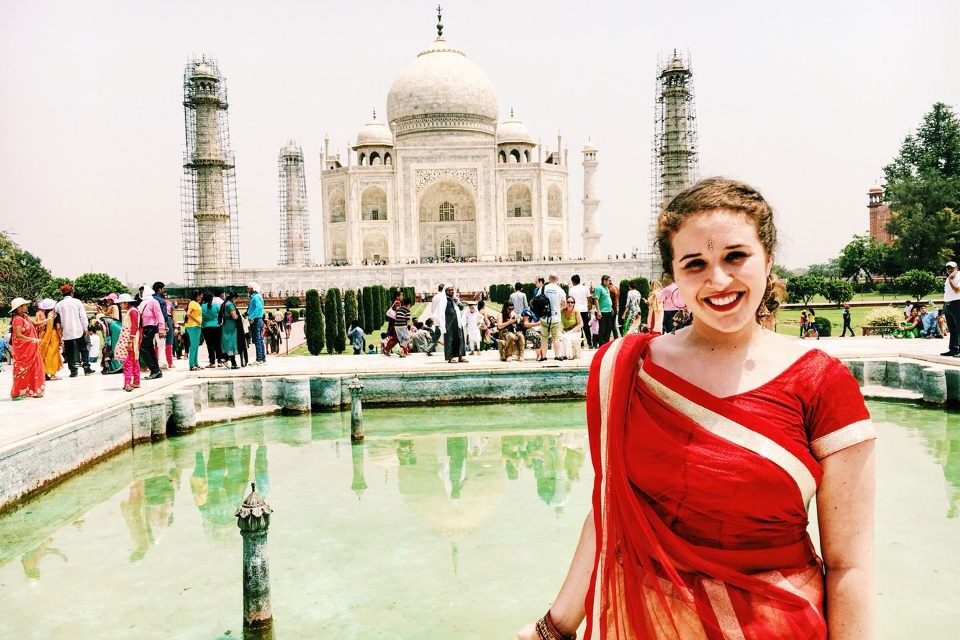 It is pouring rain. The darkness of the night presses in on Sydney Estill as she begins the journey back to her hostel. Her companion, Tom, urges they take the stone path, a shortcut through the woods. They had lost track of time and stayed out past the 10 p.m. curfew. Why does the entire populace of Rishikesh have curfew? Tigers. The couple quickly turn on their phone flashlights and begin sprinting up the stone stairs toward safety. The freezing rain stings their skin as they pick up speed. Every glimmer in the darkness could be the eyes of tigers. Estill sees the hostel ahead, and just as she feels as if her chest will explode, they reach the entrance. She pauses, trying to catch her breath, but she can’t stop laughing.
It is pouring rain. The darkness of the night presses in on Sydney Estill as she begins the journey back to her hostel. Her companion, Tom, urges they take the stone path, a shortcut through the woods. They had lost track of time and stayed out past the 10 p.m. curfew. Why does the entire populace of Rishikesh have curfew? Tigers. The couple quickly turn on their phone flashlights and begin sprinting up the stone stairs toward safety. The freezing rain stings their skin as they pick up speed. Every glimmer in the darkness could be the eyes of tigers. Estill sees the hostel ahead, and just as she feels as if her chest will explode, they reach the entrance. She pauses, trying to catch her breath, but she can’t stop laughing.
“It was the biggest adrenaline rush of my life,” Estill said. “We were drenched and exhilarated and happy to be alive.”
Estill, a student of The University of Alabama Honors College majoring in Spanish and creative advertising, took part in the Slum Teaching Project in Delhi, India, this past May. She taught English to children in the Sandesh School with hopes that it would help make them more mobile and marketable within their caste, better known as class in America. Estill lived with one of the coordinators of the program, her twin sons and her mother in Sector 29 of Delhi, also known as the fruit market.
“I wanted to feel uncomfortable in the best way possible,” Estill said. “I was anxious and didn’t know what to expect when it came to food, gender roles or attire.”
 Estill knew beforehand that dressing culturally appropriate —no bared skin or tight clothing– is extremely important in India, but she did not understand the challenge it presented until she arrived. Although she was familiar with Alabama humidity, she was floored by the sweltering heat of the country and had to take “cool and modest” to an entirely new level, purchasing silk pants, tunics and a custom Sari in order to remain completely covered without suffocating.
Estill knew beforehand that dressing culturally appropriate —no bared skin or tight clothing– is extremely important in India, but she did not understand the challenge it presented until she arrived. Although she was familiar with Alabama humidity, she was floored by the sweltering heat of the country and had to take “cool and modest” to an entirely new level, purchasing silk pants, tunics and a custom Sari in order to remain completely covered without suffocating.
“School was closed for a week when the temperature reached 130 degrees Fahrenheit,” Estill said. “The asphalt on the roads melted as people retreated to the mountains for cooler air.”
The cuisine was also a challenge for Estill when curry was for breakfast, lunch and dinner. A typical meal would be rice, curry vegetables and chapati, Indian bread made with whole-wheat flour. The culture’s meatless diet did not bother Estill, a vegetarian, but after about two weeks, she was craving a meal with more variety.
“Living in the fruit market sector, I was able to try so many exotic fruits that I had never heard of,” Estill said. “They satisfied most of my cravings for different tastes.”
Estill learned much about Indian social classes in comparison to ones in America. People in the lowest caste are referred to as “Untouchables,” and they are vertically immobile from this caste that they are born into. They are considered unclean within the culture, and they can only obtain work as servants for people of higher castes. As a guest in the homes of the elite, it is disrespectful to look the “Untouchables” in the eye. Estill said she struggled with this form of modern slavery and had to remind herself that it was a normal way of life there.
“It was an enlightening experience, walking the line between respecting who they worked for while still treating them equally as human beings,” Estill said. “My passion for the children I was teaching grew as I did not want the same life for them.”
 Of all her observations during her visit, Estill noticed one thing above the others: the importance of family. On her last night she had dinner at her program director’s home and spoke with one of their adopted sons. He worked with an outsource travel agency and made the American equivalent of $1.57 per week, an almost unbelievably low salary, considering he usually worked 12 hours a day, Estill said.
Of all her observations during her visit, Estill noticed one thing above the others: the importance of family. On her last night she had dinner at her program director’s home and spoke with one of their adopted sons. He worked with an outsource travel agency and made the American equivalent of $1.57 per week, an almost unbelievably low salary, considering he usually worked 12 hours a day, Estill said.
“He told me, ‘I have my family, and that’s all I need,’” Estill said. “I was so disgusted by the norms, but that was eye-opening.”
Estill explained that, yes, there are things to be negative about but so much more to be positive about. She said life is incredibly beautiful beyond material wealth, and as Americans we take for granted the resources at our disposal. As Estill left India, she took a new mindset with her . . . one thankful for friends, daily experiences, American pizza and lessons learned from those she thought she was teaching.






